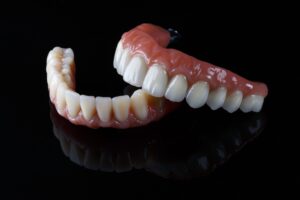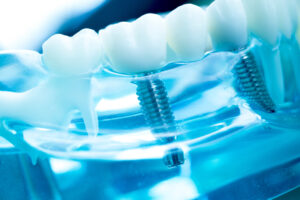Many people think that bleeding gums is something that just happens when they are brushing or flossing their teeth. The truth is, bleeding gums is not normal. While it can be attributed to brushing or flossing too hard, it is most often an early warning sign of gum disease in San Antonio, TX. If not treated, gum disease only gets worse, and can eventually lead to tooth loss. Rinsing the mouth out can help to reverse it.
Why Even Rinse?
Rinsing the mouth helps dislodge food particles and kill off bacteria currently residing in a person’s mouth. From salt-water rinses to antibacterial mouthwashes, all the options available to people are able to kill off all the harmful bacteria, while keeping their oral health balance stable!
Salt-Water Rinse:
One great way people can help their gums to heal is by rinsing with a salt-water solution. Dissolve ½ to one teaspoon of salt in a glass of warm water. This solution helps to soothe irritated gum tissue as well as draw out infection, allowing the gums to heal. Alternately, people can use a mixture of equal parts of water and a 3% solution of hydrogen peroxide.
Doctors recommend patients rinsing their mouth for at least 30 seconds with this mixture, to allow the salt or hydrogen peroxide to properly kill off all the bacterium in their mouth.
Antibacterial Mouthwash:
An antibacterial mouthwash is specifically designed to kill the gum disease causing bacteria in a person’s mouth. However, not all antibacterial mouthwashes are created equally. Some mouthwashes contain alcohol, which can actually exacerbate the situation.
Alcohol irritates the gum tissue further. Alcohol also has a drying effect on the mouth. When a person’s mouth is dry, it does not have sufficient saliva to naturally kill harmful oral bacteria. As a result, their mouth becomes the perfect host environment for bacteria and it multiplies quickly, which can then progress to gum disease.
What a trusted dentist will recommend, is a mouthwash that is specifically branded as alcohol free. These mouthwashes contain alternate antimicrobial ingredients, such as chlorhexidine, cetylpyridinium chloride, and essential oils.
“Chlorhexidine is a clinically important antiseptic, disinfectant and preservative” (ref 3), used for many decades in the healthcare industries, that works by inhibiting the inner membrane of bacterium from utilizing oxygen, effectively suffocating the bacteria and stopping it from spreading.
Cetylpyridinium-Chloride dissolves the bacterial cell membrane, killing off any bacterium that come into contact with the chemical. Various essential oils are also known to kill millions of germs.
Amp Up Your Oral Care
Mouthwash is not the only thing that can help a person’s gums to heal when they start to bleed. The entire oral hygiene routine is important. Brushing at least twice a day with a soft bristled brush along with flossing daily will help to remove plaque buildup on a person’s teeth and relieve the irritation of their gums.
Along with oral care at home, visiting a dentist regularly in San Antonio, TX can help patient’s spot gum disease problems early and take action.
Mouthwash And Saltwater Rinses Not Helping Enough?
At the end of the day, mouthwashes and rinses can only do so much to stave off the spread of gum disease, and chances are that patients will need to see a dentist to help cure their inflammation. Luckily, there are many professional options to treat gum disease, based on the severity of every patients gum disease.
Ways Periodontists Help Patients With Bleeding Gums In San Antonio, TX
No matter how hard a patient may try at home to heal their bleeding gums, they may need some specialized help from a local periodontist. Some of the solutions available to patients include the following treatments:
Scaling And Root Planning:
When it comes to keeping gum disease from recurring or getting worse, scaling and root planning remains a predictable solution. During the scaling and root planning process, a periodontist will use specialized equipment to remove any buildup on a patient’s teeth below the gumline. Once the tartar and plaque have been removed through this scaling procedure, the root planning can begin.
Root planning involves taking bacteria and any other unwanted substances off a patient’s tooth root. Typically, root planning goes hand-in-hand with scaling. The result is that a patients’ teeth are free from damaging agents, which can help their gums begin to reattach. As a result, the patient’s gums should bleed less often.
If performed at the earliest stage of gum disease, gingivitis, one scaling and root planning appointment may be enough to cure periodontal disease.
Laser Periodontics:
Like the idea of getting minimally invasive periodontal treatments? Periodontists do, too. Thanks to safe, effective dental lasers, a dental team can perform many treatments more comfortably than ever.
What type of laser periodontics might be suggested if a patient has problems with bleeding gums? With the PerioLase® MVP-7™ dental laser, this office can perform the LANAP® method for removing harmful bacteria from a patient’s gums. The laser can even take away damaged gum tissues and reshape the surface of any teeth or bone that may have been harmed by gum disease.
If a patients’ gums are bleeding around a dental implant, they may have peri-implantitis. This infection can also be treated with the PerioLase® MVP-7™. Patients can expect the procedure to be fast and the effects to be lasting.
Gingivectomy Or Gum Recession Treatments:
Sometimes, a person’s gums may bleed because they have an uneven amount of gum tissue around their teeth. Too much or too little gum tissue can lead to bleeding, particularly when flossing or brushing teeth.
With the dental laser, this practice can perform a gingivectomy to remove unwanted amounts of gum tissue. Instead of a “gummy” smile, a patient would end up with one that looked more even.
What if a patient’s underlying issue is too little gum tissue, known as gum recession? In that case, a doctor may recommend a gum graft. A gum graft replaces and restores gum tissue, so patients have a more natural, even smile.
Trust Specialists For All Your Oral Healthcare Needs
It can be hard to know where to go when gums start to bleed. A best bet is to find a periodontist with a long-standing reputation.
At a specialized office in San Antonio, TX, a team of professionals are passionate about bringing world-class periodontal procedures, treatments, and more to patients. Our practice strives to stay on the leading edge of dental technology.
To that end, this highly equipped office stays up to date on the latest strategies to solve common problems like bleeding gums, missing teeth, and gum disease.
Patient’s will appreciate the care and time that is put into developing sincere relationships with all the patients served. Patient’s will also like knowing that this office has an in-house lab that includes a3D printer, a Zirkonzahn® Milling Machine, CEREC System, and so much more. This practice can be a one-stop dental provider for anything from periodontics and cosmetic dentistry, to the placement of dental implants with robotic dental surgery.
Book Your Time To Deal With Bleeding Gums In San Antonio, TX
Does your mouth need some attention from a best-of-best dental provider? Our team includes Dr. Andrew J. Weber, Dr. Lilia Ferral, Dr. Antonella Shroeder, and Dr. Claudia Curiel. Contact our Excel Dental and Implant Center office to schedule an appointment to talk about your bleeding gums today!
References
1. Drinking alcohol is associated with variation in the human oral microbiome in a large study of American adults, BioMedical Central, https://microbiomejournal.biomedcentral.com/articles/10.1186/s40168-018-0448-x
2. How mouthwash can help fight germs in your mouth, The Health Site, https://www.thehealthsite.com/oral-health/how-mouthwash-can-help-fight-germs-in-your-mouth-100472/
3. Chlorhexidine: antibacterial action and bacterial resistance, National Library of Medicine, https://pubmed.ncbi.nlm.nih.gov/3539812/
4. The membrane destabilizing action of the antibacterial agent chlorhexidine, National Library of Medicine, https://pubmed.ncbi.nlm.nih.gov/8039666/




